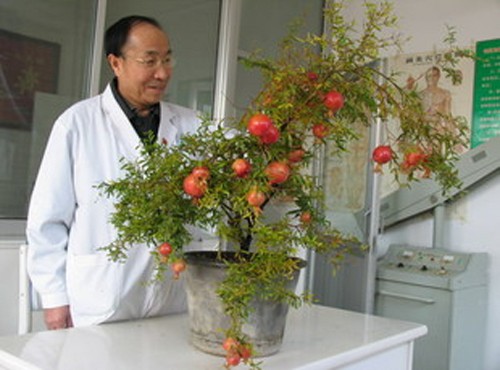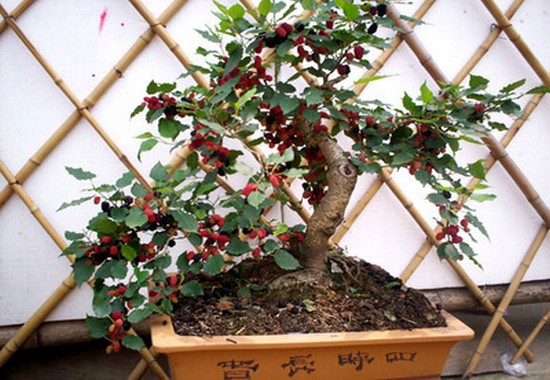Cultivation techniques of Lamei Bonsai
Wax plum blossoms in the cold month of early spring, yellow flowers, fragrance overflowing, is a unique precious ornamental flowers and trees in China. Many people do not know the cultivation techniques of preserved plum, but they are often not good. In fact, the cultivation techniques of preserved plum can be easily mastered as long as you master the essentials in four aspects.

1. Cultivation techniques of Prunus mume: mountain and field mining
The wild Lamei old root pile is cultivated under the pile in the mountain area, and it is made into the ancient pile of Lamei, which is more common and has a quick effect. Select the old stump that has been cut down for many years, and after digging it back, pay attention to protecting the root system and pruning the branches. Choose the place with moderate light, loose soil and good drainage to "raise the embryo", and then move it to the basin after survival. If it is a dog fly plum old pile, you can choose vegetarian heart preserved plum for grafting, and after survival, you can process the shape as needed.
2. The cultivation techniques of Prunus mume
1. Open field planting
Select neutral or slightly acidic sandy soil with deep soil layer, shelter from the wind and good drainage, which is generally planted before sprouting in spring. The seedlings were planted at the row spacing of 30 cm × 50 cm, and the medium seedlings of 2-3 years old were planted at the row spacing of 50 cm × 55 cm. The large seedling tree holes planted in the garden are 60-70 cm in diameter and 40-50 cm deep; the bottom of the hole is filled with rotten barnyard manure and bean cakes as base fertilizer, and after covering a layer of soil on the base fertilizer, the plum plants with soil balls are put in, filled, stamped and watered.
2. Potted plants
Choose loose, fertile and well-drained sandy soil as cultivation soil, put a layer of gravel on the drainage hole at the bottom of the basin or cylinder, select small plants with full buds in the early winter of each year, dig them up with soil, plant them in the basin, and display them after flowering. Usually put it outside in a sunny place for maintenance.
3. Water and fertilizer management of cultivation techniques of Prunus mume.
1. Watering
Usually watering to maintain the soil semi-moisture state is better, pay attention to drainage in the rainy season to prevent soil water. Replenish water in time in the dry season, and during flowering, the soil should be kept moderately dry and should not be watered too much. Potted plum is planted in spring and autumn, the pot soil is not dry or irrigated; in summer, the water is watered once in the morning and evening, and the amount of water is controlled according to the dry and wet condition of the basin soil.
2. Fertilization
Fully mature organic fertilizer was applied once a year after flower fade; mature cake fertilizer was applied every 10-15 days from spring leaf germination to June growing season; during flower bud differentiation from July to August, a mixture of mature organic fertilizer and phosphorus and potassium fertilizer was applied; organic fertilizer was applied again after autumn. After each fertilization should be timely watering, loosen the soil, in order to keep the soil loose, do not apply fertilizer during flowering.
Potted plum is no longer topdressing fertilizer and water in the early stage of potting, but leaf fertilizer should be applied in spring, turning the pot and changing the soil every 2-3 years, after the blossom fade in spring, at the same time, replace the potted soil of 1 inch and 3 years.
IV. Shaping and pruning of cultivation techniques of Lamei
Winter is the season when Lamei blossoms are in full bloom. Recently, many netizens have left messages for "Service for Nong": Lamei blossoms are generally planted in the courtyard. How did they become Lamei bonsai? Today, we will briefly introduce a method to quickly cultivate preserved plum bonsai.
1. Plastic surgery
(1) Arbor-like tree. Leave a stout branch in the seedling stage and cultivate it into a trunk without coring. When the trunk reaches the expected height, it will pick the heart and promote the branching. When the branch grows to 25 cm, pick the heart again, make it form a crown, and cut off the sprouting branches at any time.
(2) clump trees or potted plants. The heart is picked at the seedling stage to promote its branching. After the formation of the crown clump, the young shoots of the strong branches were cut off during the dormant period, the basal 2-3 buds of the weak branches were truncated, and the bore twigs, diseased and disordered branches were removed at the same time. A heart pick was carried out on the new branches of the year in the first and middle of June. Horticultural modeling is generally sprouting with a knife to break the branches to form a basic skeleton. New branches can be twisted by hand from May to June. After the basic finalization, it should be trimmed frequently to maintain the fixed style.
2. Pruning
(1) wiping buds and picking hearts in the growing season. When the leaf buds germinate about 5 cm, wipe off the dense, introverted, close to the ground of the extra buds. In the vigorous growth period from May to June, when the length of the main branch is more than 40 cm and the lateral branch is more than 30 cm, the coring is carried out to promote branching. In the rainy season, cut off miscellaneous branches, useless branches, disordered branches, wind and shade branches in time.
(2) pruning before flowering. Before the flower buds expand after falling leaves, leave one more pair of leaf buds on the flower buds for the long branches, cut off the upper part without flower buds, and remove withered branches, disease and insect branches, over-weak branches and dense, overgrown non-flowering branches and roots that are not used for renewal. Be careful not to touch the flower buds.
(3) pruning after anthesis. Remove old branches, dead branches, over-dense branches and long branches, etc., and retract the weak main branches or branches. For the main branches that are too high, too long and too strong, they can retract at the larger oblique branches, take the lead with weak branches, and control the height, length and potential of branches. Cut short annual branches, keep 30-40 cm for extended main branches, 10-20 cm for other strong branches, and leave a pair of buds or thinning for weak branches. After the flowers fade, pick the residual flowers in time.
First, sowing seeds
Some Prunus mume seeds were collected from June to July, soaked and soaked to accelerate germination, which could be pruned properly from February to March in the second year, and used as rootstocks in the spring of the third year.
2. Grafting
Looking for the favorite varieties of preserved plum in advance, 2-3 strong scions were cut in spring and grafted with rootstocks.
3. Pruning
In the year of grafting, when the scion was slightly longer than 250px, the heart was removed when the scion was slightly longer than 250px, and at the same time, the inner bore branch, overlapping branch, parallel branch and other new branches were cut off to shape the young trees.
Overall pruning: in the spring of the second year of grafting, the whole pruning was used to shape the pile embryo of preserved plum. Before the whole pruning, the branch shape of the pile embryo should be carefully observed, and then conceived. Finally, through truncation, retraction and other methods to make the wax plum show a certain posture, mainly oblique dry type and natural type.
Partial pruning: from April to May in the second year of grafting, the new flower buds were removed to make its length ≤ 250px, and from June to July, the flower buds were cut short and thinned to make the new flower buds full.
IV. Panza
At the beginning of the summer of the second year of grafting, the branches of preserved plum began to become woody and could be shaped by flat binding.
Trunk Panza: wrap one end of the aluminum wire at the intersection of the root neck and the thick root, stick to the bark and winding slowly, from the bottom up to the dry top. After wrapping the aluminum wire, start to take the bend, twist slowly, repeat many times to achieve the ideal shape curvature.
Main branch Panzha: the main branch is divided into layers and pieces in turn. Generally, the first layer has a large sagging range, and the more it goes up, it becomes smaller and smaller, until it is flat and oblique.
Unbind: unbind in time according to the growth condition (old pile 1 ~ 2 years loose, branchlets 1 year), otherwise the aluminum wire is embedded in the cortex or even xylem, causing withered branches or death.
5. Shaping
Panza that winter, there will be a small number of wax plum blossoms, select suitable flowerpots, will be transplanted into the flowerpot, covered with moss, put on the stone, so far, the wax plum bonsai has been initially completed.
It takes a total of three and a half years from the beginning of sowing and breeding to the initial formation of bonsai. If there is a ready-made old pile of preserved plum, the time can be shortened to 2 years.
Time: 2019-05-25 Click:
- Prev

How to cultivate pomegranate bonsai
For thousands of years, wild pomegranate has been cultivated and domesticated, forming two categories: one is ornamental flower pomegranate, the other is edible fruit pomegranate. There are two kinds of flowers and pomegranates for viewing flowers and fruits, but they are mainly famous for their colorful flowers. Especially when the spring is fading away and the flowers are fading away.
- Next

Pot planting technique of Zizyphus jujuba
Jujube is a deciduous fruit tree of Rhamnaceae and is native to China. Jujube is highly adaptable, barren-resistant, saline-alkali resistant and easy to manage. Potted jujube trees with early fruit, large fruit, beautiful branch shape and compact plant shape are better, such as dragon jujube, winter jujube, snow jujube, cucurbit jujube, teapot jujube and so on.
Related
- Fuxing push coffee new agricultural production and marketing class: lack of small-scale processing plants
- Jujube rice field leisure farm deep ploughing Yilan for five years to create a space for organic food and play
- Nongyu Farm-A trial of organic papaya for brave women with advanced technology
- Four points for attention in the prevention and control of diseases and insect pests of edible fungi
- How to add nutrient solution to Edible Fungi
- Is there any good way to control edible fungus mites?
- Open Inoculation Technology of Edible Fungi
- Is there any clever way to use fertilizer for edible fungus in winter?
- What agents are used to kill the pathogens of edible fungi in the mushroom shed?
- Rapid drying of Edible Fungi

